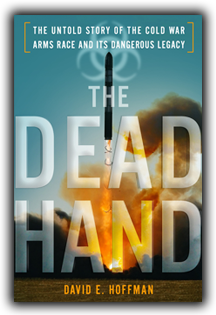New: The Dead Hand is reviewed in The Financial Times of London.
The Dead Hand won the Pulitzer Prize for general non-fiction, 2010. Read the citation!
The New York Times
By Dwight Garner
Sept. 22, 2009
“What’s particularly valuable about Mr. Hoffman’s book… is the skill with which he narrows his focus (and his indefatigable reporting) down to a few essential areas. Thanks to interviews and new documents, he provides the fullest — and quite frankly the most terrifying — account to date of the enormous and covert Soviet biological weapons program, developed in defiance of international treaties at the same time that the Soviets appeared to be earnestly interested in reducing their weapons stockpile.
This biological weapons program — Mr. Hoffman refers to it as “a dark underside of the arms race” — included the development of a super germ that mounted a grisly one-two attack on its victims: it would make them mildly ill and then, once they appeared to recover, hammer them with a death blow.
Mr. Hoffman details how truly paranoid the Soviets were that America would launch an unprovoked nuclear attack. He offers an inside account of how Mr. Gorbachev stood up to his own generals to slow and then reverse the arms race. And he is particularly good on the dangers, after the Soviet Union’s collapse, of its stockpiles of nuclear and biological weapons, much of this material stored in unguarded warehouses.”
Read the full review: The New York Times
The WashingtonPost
By Matthew Dallek
January 17, 2010
Hoffman’s book is a chillingly modern historical tale about a collective failure with lasting consequences. Chronicling the breakneck drive in the U.S.S.R. to develop methods for inflicting death on a massive scale, Hoffman captures the reckless abandon with which the Soviet Union (and the United States) pursued the arms race, from the 1970s to the early ’90s.
Read the full review here.
A huge story; an important book.
A review by Donald E. Graham on Amazon.com:
This is an astonishing book. It is a reporter’s triumph; it tells an important and (as far as I know) absolutely unknown story. It is also suspenseful and well-written; John LeCarre’s endorsement on the back on the book is well deserved.
David Hoffman is a longtime colleague on The Washington Post, but I do not think I’m overrating his book out of friendship. The story it tells is roughly this: immediately after signing a treaty banning chemical and biological weapons in 1972, the Soviet Union set about building a new, secret, and very extensive biological weapons capability. They were successful; they created frightful new weapons (a chemical weapons program was added later). Amazingly, Hoffman interviewed and has documents from scientists who led the program. The persistence (and language skills) required to get hold of these documents and conduct these interviews won’t come along again soon.
The weapons included anthrax, smallpox and plague and many more. Much of this was recovered by a ragtag team of American diplomats and scientists during the Yeltsin years. Was all of it? Probably not. (One of Hoffman’s sources was recruited to teach at a university in Iran and says that many of his colleagues went there as well).
While this story unfolds, Hoffman tells the more familiar story of Gorbachev, Yeltsin, and the unraveling of communism. He also chronicles the Soviet-US interactions in the Reagan and George H.W. Bush years, in wonderful detail and including much new data gleaned from US and Soviet negotiators.
The book is a combination of diplomatic history, suspense story, and completely original reporting. I cannot recommend it too highly.
Foreign Affairs
March/April 2010
Lawrence D. Freedman
A book that describes itself as an “untold story” should generally be met with skepticism, especially when it deals with the Cold War arms race, whose basic story is well known. Yet this thoroughly researched and always interesting book has earned its subtitle: it not only adds intriguing detail to the interplay between Ronald Reagan and Mikhail Gorbachev in the 1980s and gives due recognition to the role of Margaret Thatcher and British intelligence; it also breaks new ground by getting inside the dark and obsessive parts of the Soviet military machine. The “dead hand” of the title was something akin to the Doomsday Machine dreamt up by the nuclear strategist Herman Kahn, in this case a device that would automatically launch missiles against the United States in the event that the Soviet leadership was taken out by a U.S. attack — a scenario that was actively feared during the fevered early 1980s. As startling a project, because of its lingering effects, was the Soviet Union’s work on biological weapons, which resulted in one catastrophic accident with anthrax in Sverdlovsk in 1979 and risked much worse. Hoffman describes the efforts to close down the program just as the Cold War was ending and implies that they never quite succeeded.


